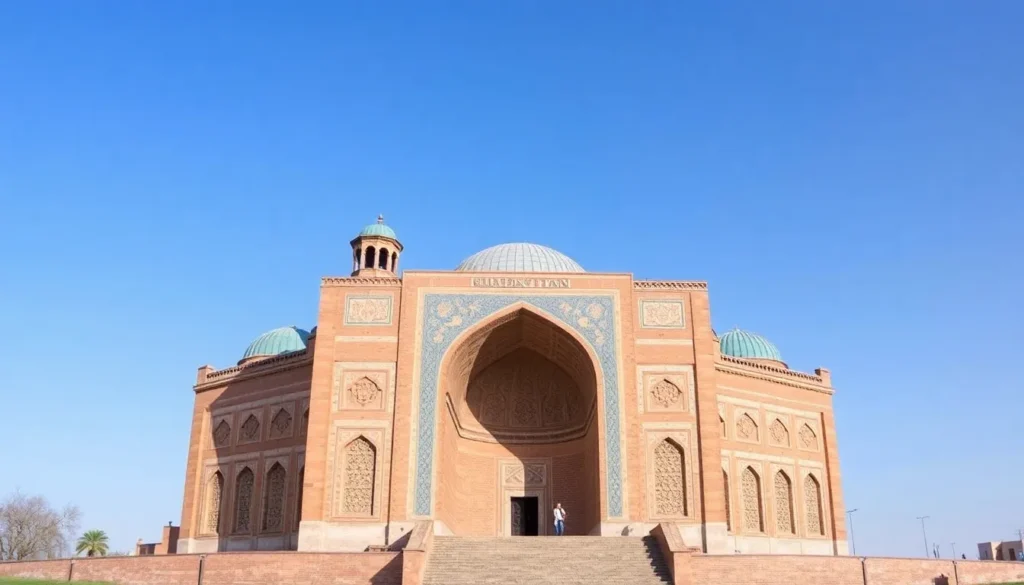Brief Overview of Uzbekistan's History

- The early inhabitants and the Persian Empire
- The conquests of Alexander the Great and the Seleucid Empire
- The Kushan Empire and the birth of the Silk Road
- The Sasanian Dynasty
- Cultural Expansion and Territorial Changes
- The Russian Empire's entry into Uzbekistan
- Recent history of Uzbekistan
- Uzbekistan today
Uzbekistan is a country steeped in a rich tapestry of history, marked not only by conquests and territorial shifts but also by significant cultural and scientific advancements. To truly understand Uzbekistan is to grasp the essence of the Silk Road, the Tsarist Empire, and the Soviet legacy. This Central Asian nation is a hidden jewel, often overshadowed by its larger neighbors and yet bursting with stories waiting to be uncovered.
With neighbors often referred to as "the stans"—where "stan" translates to "land of"—Uzbekistan translates to "land of the Uzbeks." However, the complexity of its history and cultural heritage goes much deeper than mere nomenclature. Join me on an immersive journey through the captivating history of Uzbekistan.
The early inhabitants and the Persian Empire
Before the rise of the Sogdian and Bactrian civilizations, the region now known as Uzbekistan was sparsely populated. Archaeological evidence points to early settlers along the fertile valleys between the Amu Darya and Syr Darya rivers. The Sogdians thrived in the northern regions, while the Bactrians flourished in the south, both contributing to the rich tapestry of Central Asian history.
Unlike many areas in Central Asia, Uzbekistan was not dominated by nomadic tribes. Instead, its inhabitants established permanent settlements that endured through various historical epochs. By 545 BC, the arrival of Cyrus II marked a pivotal moment in the region’s history, as he founded the Achaemenid Empire, which would eventually stretch from the Iranian plateau to Mesopotamia.
Interestingly, the roots of one of the world's earliest monotheistic religions, Zoroastrianism, are closely intertwined with Uzbekistan. Though often categorized as an Iranian religion, it is believed to have developed significantly in regions corresponding to modern-day Uzbekistan.
The conquests of Alexander the Great and the Seleucid Empire
In 327 BC, the legendary conqueror Alexander the Great seized control of Sogdiana and Bactriana, leading to the decline of the Achaemenid Empire. His reign, however, was short-lived; he died under mysterious circumstances in Babylon in 324 BC. Following his passing, Seleucus I Nicator, one of Alexander’s generals, claimed the territory, establishing the Seleucid dynasty, which persisted until the 1st century AD, despite ongoing conflicts and invasions.
The Kushan Empire and the birth of the Silk Road
The period between the 1st century BC and the 2nd century AD was characterized by invasions from nomadic groups from China, notably the Kushan Empire. This invasion brought two significant changes: the spread of Buddhism and the initiation of an extraordinary trade route known as the Silk Road.
The Silk Road was not merely a single path; it was a network of interconnected routes that facilitated trade between Europe, Asia, and the Middle East. It enabled not only the exchange of precious goods but also the spread of ideas, cultures, and knowledge that would otherwise remain isolated.
The Sasanian Dynasty
In 224 AD, the Persians reclaimed territories lost centuries earlier, heralding the rise of the Sasanian Empire, which became a formidable rival to Rome. The revival of the Silk Road during this period attracted various warrior tribes, including the Mongolian White Huns. The Sasanian Empire managed to resist these invasions through alliances, yet still lost portions of Uzbek territory in the process.
Cultural Expansion and Territorial Changes
The arrival of the Arabs
The 8th century witnessed another transformative event in Uzbekistan's history with the advent of the Arabs, led by Qutaiba ibn Muslim, who brought with them Islam, a religion that would significantly reshape the region. Initially met with resistance from the local population, who adhered to Zoroastrianism, the Arabs implemented both coercive and attractive measures, including tax exemptions for converts.
The height of Islamic influence came with the Abbasid Caliphate, during which arts, culture, and sciences flourished. Notable figures from this era include Al Khwarizmi, the father of algebra, and Al Farghani, a prominent astronomer.
As centuries passed, various dynasties rose and fell, including the Samanids, the Qarakhanids, and the Seljuks, each contributing to the rich historical narrative of Uzbekistan.
Genghis Khan and the Mongol Invasion
In 1219, the infamous Genghis Khan arrived in Uzbekistan, marking the onset of Mongol dominance characterized by widespread destruction. The Mongol Empire introduced a new era of brutal conquests, yet paradoxically, left certain architectural marvels intact, including the Grand Minaret of Kalon in Bukhara, which captivated Genghis Khan's eye.
Tamerlane, Uzbekistan's national hero
Fast forward to 1336, the birth year of Amir Timur, better known as Tamerlane. This iconic figure, whose name translates to "Timur the Lame," is revered in Uzbekistan, where the use of his nickname is considered disrespectful. Tamerlane was a cultured man with a passion for the arts and sciences. During his reign, he established Samarcanda as the capital, adorning it with magnificent monuments.
His ambitions for conquest were fierce; he sought to expand his empire as far as the Ottoman Empire and had aspirations to reach China. However, his journey was cut short by his death during his campaign. The Timurid dynasty, which he founded, lasted until around 1500 when the Chagatai Khanate, a Mongolian tribe from which the Uzbeks descended, succeeded it. The capital shifted to Tashkent, and the realm was divided into various khanates.
Interestingly, one of Tamerlane’s descendants, Ulugh Beg, gained fame not as a ruler but as an advanced astronomer and mathematician.
The Russian Empire's entry into Uzbekistan
The Tsarist Empire
By the 18th century, facing relentless raids from Turkmen and Kazakh marauders, the Khan of Khiva sought help from Peter the Great, the Tsar of Russia. However, the Russian expedition encountered hostility, leading to the execution of its soldiers. Over time, relationships soured significantly.
The Russian Empire began to annex the territories of present-day Kazakhstan and Uzbekistan around 1868, led by General Mikhail Chernyayev, establishing the region as Turkestan, with Tashkent as its capital. The Tsarist interest in this region stemmed from both geopolitical rivalry with Great Britain and strategic ambitions to access the Indian Ocean.
The Russian Revolution and the Soviet Union
The year 1917 marked a turning point with the fall of the Tsarist regime and the birth of the Soviet Union, profoundly impacting Central Asia, including Uzbekistan. In 1924, borders were drawn to establish Uzbekistan as a distinct entity, although these borders often disregarded ethnic distributions, sowing seeds for future conflicts.
Stalin’s policies in Uzbekistan during the Soviet era led to forced labor, particularly in cotton harvesting, and the infamous purges that swept through the nation. Religion was systematically repressed, with mosques and madrasas being closed. Yet, it was also a period of progress, with significant advancements in education, healthcare, and women's rights.
The Second World War
The impact of World War II was felt acutely in Uzbekistan, where countless Uzbeks were conscripted into the military, with estimates suggesting that only a third of the 1.4 million who served returned home. The tragic story of 101 Uzbek soldiers captured by the Nazis and executed in a Dutch concentration camp remains a dark chapter in this history.
The cotton crisis
Cotton, often termed "white gold," became pivotal to Uzbekistan's economy, particularly from the 1960s to the 1980s. The intensive cultivation driven by escalating demand led to disastrous environmental consequences, including the depletion of the Amu Darya and Syr Darya rivers. Consequently, the Aral Sea shrank dramatically, devastating local fishing communities and creating public health crises due to exposed salt and toxic particles from previous Soviet experiments.
Tragically, this environmental disaster was compounded by forced labor practices during the cotton harvest, with children often pulled from schools to participate in grueling labor under poor conditions—a practice that persisted long after the Soviet era.
Recent history of Uzbekistan
The fall of the USSR and the Karimov era
In 1991, the dissolution of the Soviet Union heralded the emergence of five independent Central Asian republics, including Uzbekistan, with Islam Karimov as its first president. Having been a key player in the Soviet government, Karimov won the first national elections with over 86% of the vote.
In 1992, Uzbekistan adopted a constitution declaring it a secular, democratic republic, although Karimov's administration quickly revealed authoritarian tendencies, suppressing opposition and curbing media freedoms.
Karimov's dictatorship masked as democracy
Regarded as the last vestige of Soviet authoritarianism, Karimov's rule was marked by severe repression, with a complete lack of political opposition and numerous human rights abuses. Uzbekistan became one of the most opaque and reclusive regimes in the world, drawing comparisons to North Korea.
The Andijan massacre
Karimov's regime was particularly focused on combating Islamic extremism, leading to strained relations with the West. However, the 2005 massacre in Andijan caused a significant rift. Following an armed attack on a prison, thousands gathered in the city to protest against the government, only for the military to respond with lethal force. Estimates of the death toll range from 500 to 1,000, while the government maintains a figure of just 187.
The death of Karimov and the rise of Shavkat Mirziyoyev
Karimov's tenure came to an abrupt end with his death in 2016, paving the way for Shavkat Mirziyoyev to assume the presidency with 88% of the vote, albeit under contentious circumstances. Mirziyoyev's administration has begun to implement reforms, fostering a more open foreign policy and a visa-free regime for over 50 countries, including Spain.
Since taking office, Uzbekistan has seen notable economic growth, and foreign investments have surged by 50%. In a significant shift, Mirziyoyev dismissed the notorious head of the secret police, Rustam Inoyatov, known for his oppressive methods.
Moreover, the release of political prisoners, including journalist Muhammad Bekjan, symbolizes a positive change in Uzbekistan's human rights landscape.
In October 2021, Mirziyoyev was re-elected, despite allegations of electoral irregularities, leading to continued scrutiny of his regime's transparency and governance.
Uzbekistan today
Today, Uzbekistan stands at a crossroads, gradually embracing modernization and transparency. The government’s openness to tourism and international relations signals a new chapter for the nation. The path ahead remains fraught with challenges, including ongoing struggles against corruption and the need for deeper reforms. Uzbekistan is ranked 146th in the corruption perception index, highlighting the work still required to improve governance and civil liberties.
Uzbekistan's fascinating journey is a testament to the resilience of its people and their enduring spirit. As this Central Asian nation continues to evolve, understanding its past will be crucial to appreciating its future.
For more insights into Uzbekistan and its captivating history, consider watching this enlightening video:




Deja una respuesta